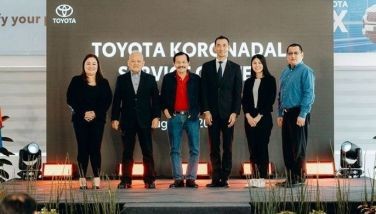Rolling them out on the road

In a visit to the new office building of The STAR last Friday, former Ilocos Sur Governor Luis “Chavit” Singson (LCS) arrived on board his controversial heavily armored car. Assembled by his own company called BMW, or the Baluarte Motor Works, Singson’s bullet- and bomb-proof vehicle made a grand entrance at our office building at the Amvel Business Park in Parañaque City.
This was the same vehicle that traffic enforcers pulled over last April along the northbound lane of the EDSA Carousel in Cubao, Quezon City. Traffic enforcers of the Metro Manila Development Authority (MMDA) stopped Singson’s armored vehicle while it was passing through the lane exclusively for use of public utility buses (PUBs). Singson paid the P5,000 fine right then and there on the road.
“Congratulations to the MMDA enforcers who accosted my convoy. I am not angry. I will even give them cash incentive,” Singson announced to media. Days later, Singson made good his promise and turned over the P100,000 check as cash incentive donation to the MMDA.
Singson’s passion for motor vehicles extends all the way to the common Filipino’s popular mode of transport, the iconic public utility jeepneys (PUJs). In fact, his LCS Group of companies – bearing his initials – has branched out to the manufacture and assembly of electric-run PUJs. Singson’s newest company has put together 21 partner companies in South Korea engaged in the production of e-vehicles.
Called E-Mobility, Singson disclosed the first prototype e-jeepney is scheduled for delivery in Manila this month. Unlike the old PUJs that run on diesel, the e-jeepney is more environment-friendly and tested safe and more convenient to passengers, Singson pointed out. According to Singson, his e-jeepney could seat 22 passengers and fit in six more people standing.
Supposed to be patterned after our country’s traditional PUJs, Singson’s e-jeepney though looks more like a mini-bus. From the video shown to us by Singson, his e-jeepney resembles the modern PUJ units already plying the Baclaran-Baltao route in Sucat. Operated by a transport cooperative in Parañaque City, these units run on diesel.
Singson offered his e-jeepney project to Department of Transportation (DOTr) Secretary Jaime Bautista to include it as an option for compliance under the government’s public utility vehicle modernization program (PUVMP). Singson offered his e-jeepney at P1.2 million each in a rent-to-own repayment arrangement. Without any down payment, he explained, the drivers will just pay half of their daily earnings to their drivers’ group which in turn remits the payment to E-Mobility.
Singson, who turns 83 years old this coming June 21, tells us he has totally retired from politics. Thus, he swears his offer is not targeting to win popular support from the militant drivers’ groups that continued with their transport strikes to oppose the PUVMP. Following the lapse of the deadline last April 30, all existing PUJ franchises still not consolidated under PUVMP will lose their routes at the Land Transportation Franchising and Regulatory Board (LTFRB).
According to the study done by the Congressional Policy and Budget Research Department (CPBRD), daily traffic from PUJs decreased by half to 95,659 in 2023, from 193,221 in 2013. On the other hand, the volume of private cars rose by nearly half to 3.35 million, from 2.28 million, during the period. Thus, the traffic crisis in Metro Manila can be attributed to the growing volume of private vehicles amid the shrinking availability of PUB and PUJ units. At the same time, the number of motorcyles grew by almost four times in the past 10 years, with the booming e-commerce demand and the entry of two-wheeled transport services.
Many of the well-intentioned programs like the PUVMP suffer at the implementation stage. The PUVMP, in particular, has long been stalled precisely due to obvious lack of good faith and equity on the part of the government.
Take the case of another LTFRB program on the motorcycle (MC) taxi pilot study that Congress had earlier required the agency to conduct. Despite running for five years, the DOTr-TWG has yet to complete the MC taxi pilot study. The Congress has also yet to approve laws for MC taxis. Also still pending at the public policy development is the LTFRB’s guidelines for the four-wheeled transport vehicle network services (TNVS) that has long been in the pipeline.
Last week the ride-hailing and delivery service Grab Philippines (Grab) and e-vehicle manufacturer BYD company took it upon themselves to do their own pilot study. The two companies jointly announced in a statement their partnership for a pilot study that aims to test the feasibility of using e-vehicles for TNVS. Their e-vehicle pilot study will run for one month in Taguig’s Bonifacio Global City, Makati City, Pasay City and Mandaluyong City to leverage the existing e-vehicle charging infrastructure in the areas.
LTFRB chairman Teofilo Guadiz III reportedly expressed support for the pilot study, citing it advances the country’s transportation landscape through the use of “innovation and sustainable solutions.”
This affirms the positive impact of ride-hailing apps and transport networking services on our country’s economy. Previous studies have shown that for every peso spent on these transport services, P3.42 more is generated within our country’s economy. This multiplier effect is manifested through more self-employment and entrepreneurial activities of the drivers themselves, the merchants, direct and indirect employment of allied businesses like fuel supply services, vehicle manufacturing, advertising, packaging, etc. Thus, these will all translate to higher disposable income and consumer spending of families within and outside the TNVS industry.
The data culled from these studies are important, particularly for regulators and legislators to take note of. The government policies on this relatively new industry have long been in the pipeline and have up to now not yet been finalized.
But how long does it take the government to develop policies?
Putting up more efficient mass transport system has already become a pipe dream to us Filipinos. Yet the government is not even trying to help nurture the ride-hailing industry. Rolling out these pilot studies on the road will show in real terms their major contribution to our country’s economic development.
- Latest
- Trending

























